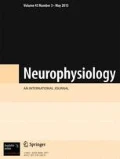Abstract
The effects of a biotechnological probiotic product, PP, produced by food fermentation with Lactobacilli (US patent approved), on the growth of neurites in rat pheochromocytoma cells (PC-12) and on calcium responses of rat brain neurons were studied in culture. The PP increased the length of neurites in PC-12 cells, resulting in an irreversible differentiation of cancerous cells into neuron-like structures. Moreover, a change in the neurotransmitter phenotype of differentiated cells was found; some cells, such as excitatory neurons, began to respond to glutamate application by increasing [Ca2+] i . The PP directly activated PC-12 cells and neurons by the release of Ca2+ from the intracellular stores in a steady manner. The PP also stimulated the entry of Ca2+ into the cells in a Ca2+ add-back protocol, which was considerable upon washing out of PP. Thus, the products of Lactobacillus metabolism, such as those in PP, can act as a neuronal growth factor and manifest clear pharmacological reactions at the cellular level. By comparison, commercial lyophilized probiotic bacteria also induced a Ca2+ rise in neurons, but not in PC-12 cells. Some neurons did not respond to probiotic bacteria, and some neurons responded with some delay. Upon wash out of probiotic bacteria, a huge entry of Ca2+ into the cells was observed.
Similar content being viewed by others
REFERENCES
G. Reid, M. E. Sanders, H. R. Gaskins, et al., “New scientific paradigms for probiotics and prebiotics,” J. Clin. Gastroenterol., 37, 105–118 (2003).
K. Kamm, S. Hoppe, G. Breves, et al., “Effects of the probiotic yeast Saccharomyces boulardii on the neurochemistry of myenteric neurones in pig jejunum,” Neurogastroenterol. Motil., 16, 53–60 (2004).
L. A. Greene and A. S. Tischler, “Establishment of a noradrenergic clonal line of rat adrenal pheochromocytoma cells which respond to nerve growth factor,” Proc. Natl. Acad. Sci. USA, 73, 2424–2428 (1976).
C. V. Sobol, “Mechanisms of vasoconstriction induced in frog vascular smooth muscle by MD1, a new biotechnological agent,” Gen. Physiol. Biophys., 14, 293–303 (1995).
C. V. Sobol and Yu. Ts. Sobol, Composition and Method for Producing and Use of a Fermented Hydrolyzed Medium Containing Microorganisms and Products of Their Metabolism, US Patent Application 20030235559, filed of June 21, 2002; US patent approved and soon to be published (2005).
H. Isoda, H. Shinmoto, M. Matsumura, and T. Nakahara, “The neurite-initiating effect of microbial extracellular glycolipids in PC12 cells,” Cytotechnology, 31, 163–170 (1999).
R. C. C. Chang, P. Hudson, B. Wilson, et al., “Influence of neurons on lipopolysaccharide-stimulated production of nitric oxide and tumor necrosis factor-α by cultured glia,” Brain Res., 853, 236–244 (2000).
N. J. Rothwell, “Sixteenth Gaddum Memorial Lecture December 1996. Neuroimmune interactions: the role of cytokines,” Br. J. Pharmacol., 121, 841–847 (1997).
J. G. Sheng, S. H. Bora, G. Xu, et al., “Lipopolysaccharide-induced neuroinflammation increases intracellular accumulation of amyloid precursor protein and amyloid beta peptide in APPswe transgenic mice,” Neurobiol Dis., 14, 133–145 (2003).
G. K. Povlsen, D. K. Ditlevsen, V. Berezin, and E. Bock, “Intracellular signaling by the neural cell adhesion molecule,” Neurochem. Res., 28, 127–141 (2003).
L. B. Rosen, D. D. Ginty, M. J. Weber, and M. E. Greenberg, “Membrane depolarization and calcium influx stimulate MEK and MAP kinase via activation of Ras,” Neuron, 12, 1207–1221 (1994).
M. P. Mattson and S.B. Kater, “Calcium regulation of neurite elongation and growth cone motility,” J. Neurosci., 7, 4034–4043 (1987).
J. Szeberenyi, P. Erhardt, H. Cai, and G. M. Cooper, “Role of Ras in signal transduction from the nerve growth factor receptor: relationship to protein kinase C, calcium and cyclic AMP,” Oncogene, 7, 2105–2113 (1992).
K. Kurozumi, T. Murayama, and Y. Nomura, “Generation of inositol phosphates, cytosolic Ca2+, and secretion of noradrenaline in PC12 cells treated with glutamate,” FEBS Lett., 270, 225–228 (1990).
C. F. Pereira and C. R. de Oliveira, “Oxidative glutamate toxicity involves mitochondrial dysfunction and perturbation of intracellular Ca2+ homeostasis,” Neurosci. Res., 37, 227–236 (2000).
Author information
Authors and Affiliations
Corresponding author
Additional information
Neirofiziologiya/Neurophysiology, Vol. 37, No. 3, pp. 284–293, May–June, 2005.
Rights and permissions
About this article
Cite this article
Sobol, C.V., Belostotskaya, G.B. & Kenworthy, M.W. Calcium Signalling in Rat Brain Neurons and Differentiation of PC-12 Cells Induced by Application of a Probiotic Product. Neurophysiology 37, 251–260 (2005). https://doi.org/10.1007/s11062-005-0072-9
Received:
Issue Date:
DOI: https://doi.org/10.1007/s11062-005-0072-9




